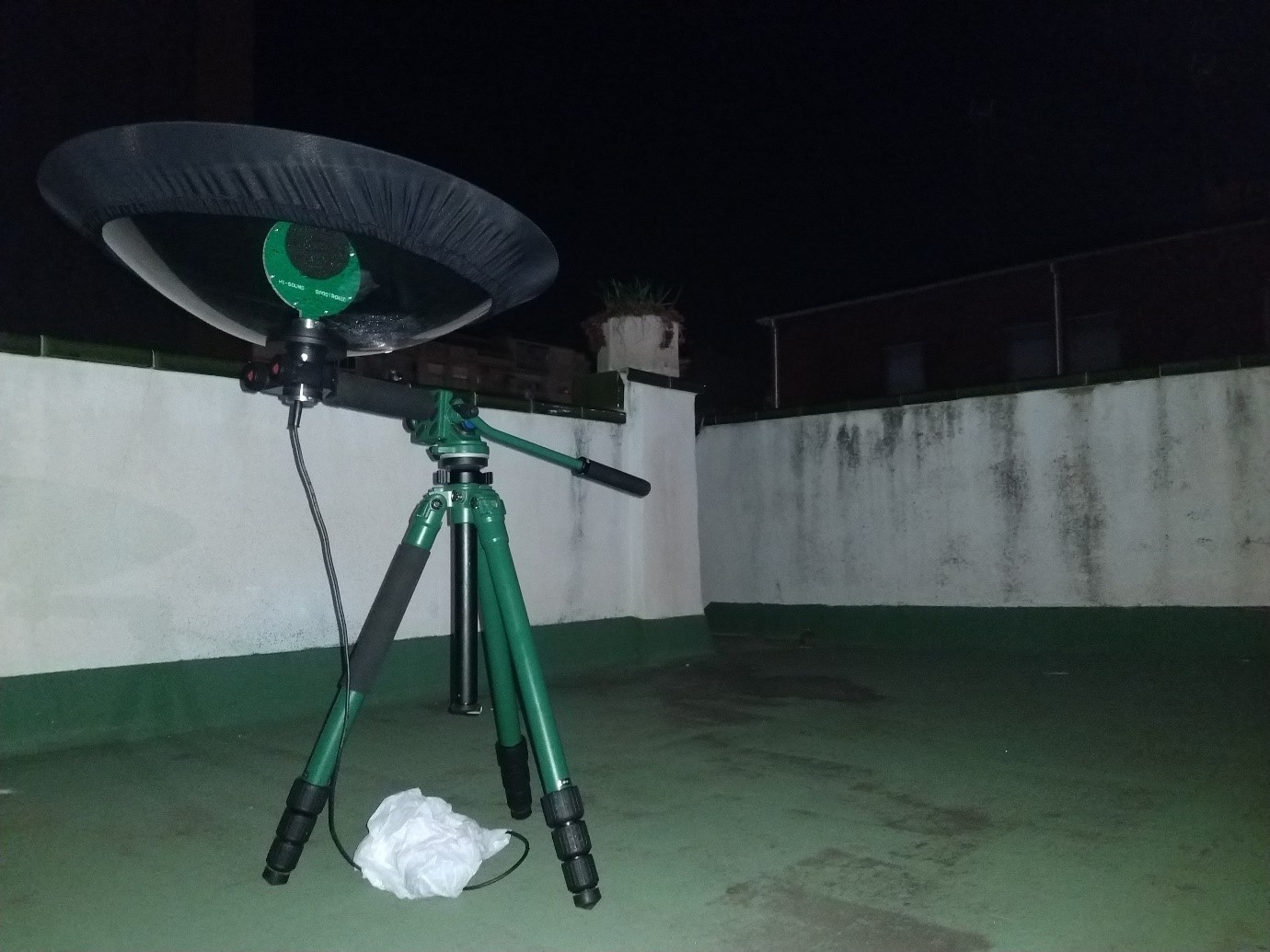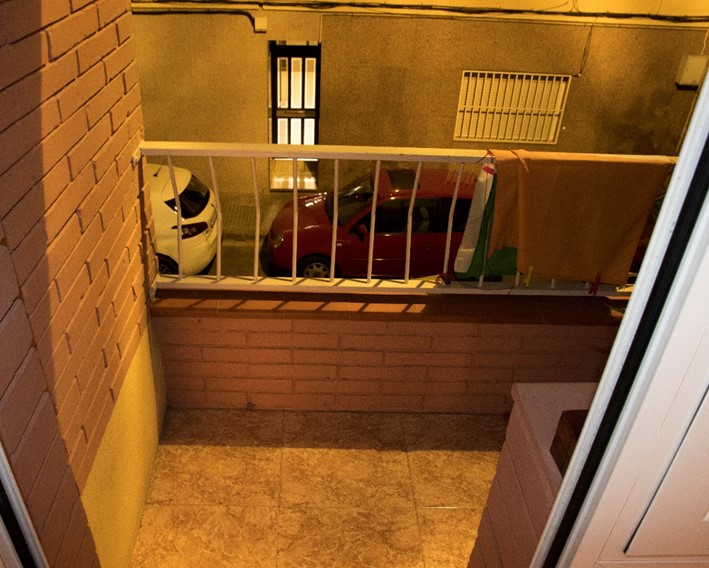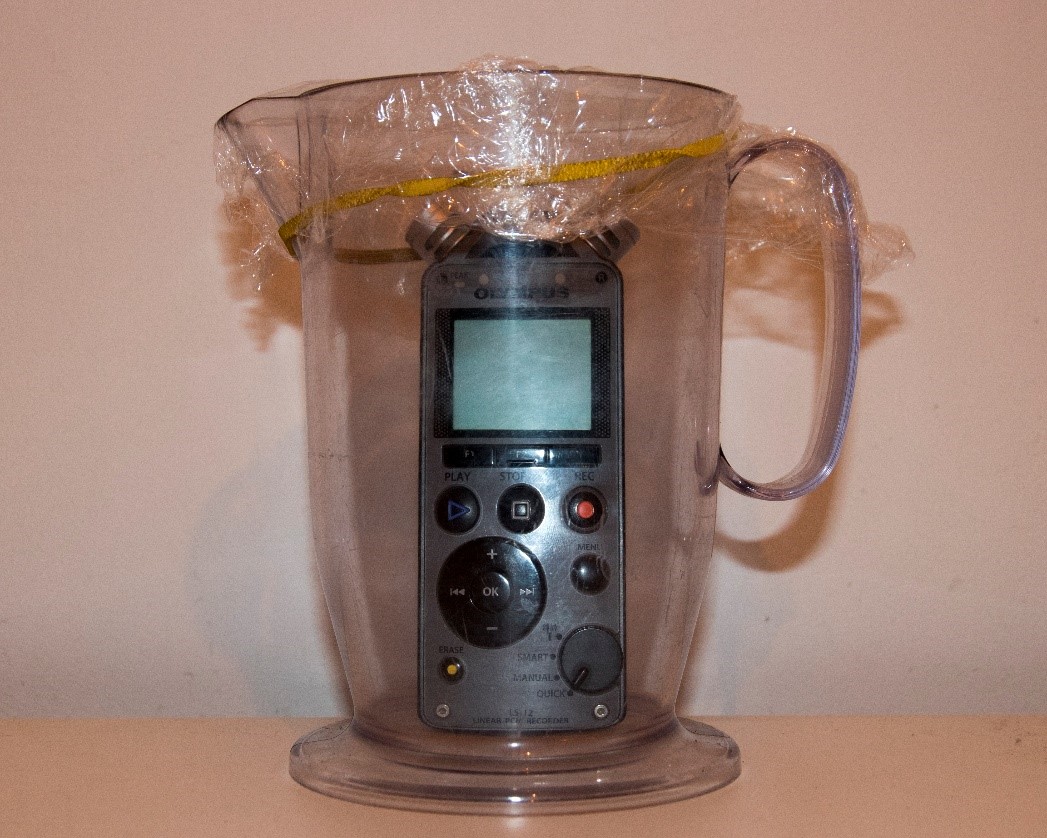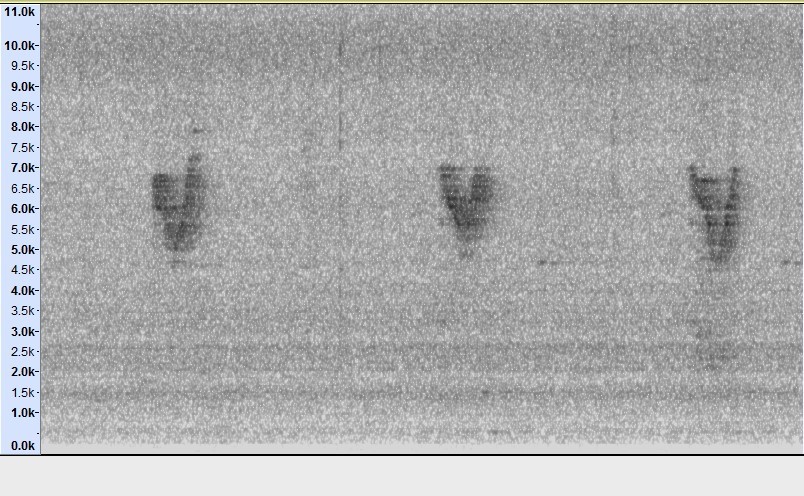Since September 2019 my perception of the birdlife surrounding my urban apartment has changed vastly, and for the better. In 2018 I moved from my hometown of Cobh, Co Cork, to El Prat de Llobregat, a suburban city on the outskirts of Barcelona. My partner, a native of El Prat, couldn't take any more of the Irish weather – not that I blame her!
Saying that, it wasn’t the most difficult of moves – the food and weather are great, the birding is phenomenal and I am blessed to have Llobregat Delta, a fantastic nature reserve, just a few km away. Here I saw a total of 213 species on my newly adopted patch in 2019, the highlight being a lovely self-found spring Citrine Wagtail.

Seán's current Dodotronic Hi-Sound Stereo Parabola setup (Seán Ronayne).
Although so close to the delta, my apartment and its surrounds were strikingly birdless in comparison. During the day, my views typically consist of high-rise apartments, concrete, traffic, people and an array of urban-dwelling birds: Feral Pigeon, Yellow-legged Gull, Monk Parakeet, locally nesting Alpine Swifts, and the occasional migrant in some of the few trees or suitable small gardens. Little did I know how noc-mig would change this impression, even bringing a Siberian vagrant to my very doorstep.
My journey into the mysterious world of nocturnal migration began unexpectedly in September 2019. Every year here in Catalonia, we have a birding festival, akin to the British Birdfair. Set in the heart of the Ebro Delta and with several fascinating talks lined up, I booked a ticket. Scanning through the schedule, I was excited about the line-up, but my mind kept coming back to Magnus Robb's talk on sound-recording nocturnal migration, on the Saturday.
I had read about noc-migging in the past but had never given it any serious thought. I only had an Olympus LS-12 handheld recorder and couldn't afford or justify buying an external microphone or parabolic. I had heard of the recent discovery of a previously undetected migration route of Ortolan Bunting through southern England as a result of noc-migging efforts and was impressed. But that was it – I never once thought of trying this out for myself.
The day came and I accidentally arrived late into Magnus' talk after getting distracted by an intermedius-type Lesser Black-backed Gull en-route to the marquee. The audience was in silence and were clearly captivated. Magnus vividly explained his journey into noc-mig in an articulate and enthralling manner and really opened my eyes to this other birding world, as well as the eyes of every other person in the room – even the door staff seemed to be following with anticipation!

The Catalonian balcony from which Seán records (Seán Ronayne).
He spoke of all kinds of birds one couldn't imagine flying over their house and it set my imagination into overdrive. He spoke of recording a vagrant Upland Sandpiper over his own garden in Portugal and of birds I wouldn't have even imagined calling on migration whatsoever. This was something new and truly fascinating. It didn't take me long at all before I began to wonder what might be flying over my own bird-less apartment.
Arriving somewhat late, I had missed the part where equipment was discussed, so after the talk I approached Magnus and asked him whether it would be worth attempting recording with just the recorder as it is – no shotgun mic or parabolic. I thought this was a rather daft question, thinking I would have nowhere near enough reach to record high-flying migrants, and was pleasantly surprised when he answered positively, and in fact encouraged me to try it as such. This was great! My next mad experiment was in the pipeline and my partner laughed and rolled her eyes – giving me that 'here we go again' look.
I wasted no time and upon arrival back home I started googling some ideas. Some people put their handheld recorders in large pots, protecting them with umbrellas or cling film – didn't have any pots so I used a measuring jug, with some cling film and an elastic band instead. I was surprised to read that the Olympus LS-12 would run all night recording without the need for any external power source. So, before bed, I set my recorder to record, put it into the measuring jug and secured it with cling film. I put it out on my balcony and to be honest I didn't expect to get anything. Not in my concrete, urban, bird-free zone …

A recorder, a measuring jug and some cling film were the beginnings of Seán's noc-mig efforts (Seán Ronayne).
The following morning I took my recorder in and uploaded my recordings. They were split into sections, each containing three hours and 22 minutes. I uploaded the first into Audacity – an excellent free sound recording software and began to process. I followed some very clear guidelines illustrated by Joe Stockwell on YouTube (see here) which further reinforced in my mind, what Magnus had said in his talk.
I changed the audio file from waveform to spectrogram. This takes a few minutes to change because of the large file size. I then zoomed in so that one second was approximately half an inch wide on my monitor – this meant that 14 seconds are visible across my monitor for each frame. I clicked on the bottom slider once and that brought me to the next 14 second frame. Like this I slowly scanned for anything that looked like a bird call. In the beginning I was stopping for every little sound, soon learning all of the irregular sounds of the night on my street: cats, dogs, people vomiting after a few too many, roof-top wind chimes, budgies, bats and so on.
The first morning of processing was a steep learning curve full of new sounds which, to my untrained eye, looked like bird calls. I scrolled through hours of data with no actual birds at all, then at about 4 am I saw something different. Was this a bird? I listened and it sounded heron-like. The quality wasn't very good – was it a Black-crowned Night Heron? I cross-checked it on Xeno-Canto and it was a match. Wow – an actual bird! This was by far the best species I had ever recorded from my apartment. They aren't really difficult in the delta, a 10-minute drive away but this was special. I was hooked.
The following night I put my recorder out again and the next day I discovered a Tree Pipit had flown over my apartment at 3.27 am, giving a single distinctive call. Now I knew my little recorder was capable of picking up small passerines too. It was great news and I was set for some autumnal migration.
Over the next few nights I added some, previously unthinkable species to my apartment list, such as Firecrest, Redwing, Song Thrush, Blackbird, Common Moorhen, Grey Heron, Green and Common Sandpipers. Every night I had something. Thrush numbers built up and I started to record a surprisingly high number of Redwings. This is a scarce species in the delta – I only saw one bird the previous year, so recording 91 bird in a night was quite exciting.
Before I knew it I was into October and things were getting exciting. This time of year my mind is always on easterlies and potential vagrants. On 22 September the wind was blowing hard from the east and had been for a day or so before that. It was a good time for Yellow-browed Warbler and so I got some work done in order to clear some time in the morning to head out and search for any wind-strewn waifs. That night the wind was incredibly strong, as was the rain, but I decided to put the recorder out anyway. I thought I wouldn't capture any birds on it, but I had nothing to lose so I put it out anyway. I trusted my cling film-covered contraption to keep it dry.

The sonogram of the Yellow-browed Warbler Seán recorded (Seán Ronayne).
The next morning was exciting. I went to one of my local spots and found lots of migrants, but all common. Still, it was nice to see so many Song Thrushes still flying over calling and my first Goldcrests of the year. I spent a good two hours slowly walking my little spot in the hope something rare had made landfall but it just wasn't meant to be.
I played a call of a Yellow-browed Warbler towards a treeline where I had seen two last year, in a last-ditch attempt to find something rare. I was met with silence and off I went back home. Before I left, I looked at the recording just to see the shape of the call on the sonogram – it was a very distinctive v-shape and it reminded me of the birds I had recorded at the very spot last year.
When I got back home, I decided to go through my recordings from the night. I did my usual process and set it up to scroll, frame by frame. I could see the weather had been hammering my cling film top with lots of noise showing up on audacity – I really wasn't expecting anything. Then, just minutes in, something jumped out at me – it was a bird. I laughed to myself and said "Ha, that looks like a Yellow-browed Warbler". It must have been an odd call from one of the neighbouring apartment's pet birds, I thought.
I put my earphones in and decided to see what it actually was. I pressed play and instantly jumped up off my seat and started screaming expletives. My partner stuck her head around the corner and looked at me like I had lost my mind. It was a Yellow-browed Warbler! I couldn't believe it. What are the chances? My apartment is amid an urban jungle with loud cars, tall apartment blocks, barking dogs and only the occasional tree or two. I listened again, a little calmer, just to make sure I didn't just imagine it. It was undoubtedly a Yellow-browed. I sent out some messages to a few friends who were equally as surprised. This was the moment I became truly obsessed.
From hereon in I've been recording every night and reading everything I can get my hands on. Admittedly, I find it difficult sometimes to pin an ID on certain birds. Hearing a snippet of call in a completely out of context situation can be very difficult and I've learned that you sometimes just have to let such birds go. Thankfully, there are some great resources in Xeno-Canto, as well as my own friends and contacts. It's been a massive learning curve, will continue to be so and I'm loving every minute of it.
A few days after the Yellow-browed Warbler, I added both Brambling and Hawfinch to my apartment list in a single night. Hawfinch is a bird which has taunted me throughout my birding career, with fleeting glimpses in Poland, failed trips to the only reliable Irish site and a failure to connect with any birds during the big influx of 2017. So, to say Hawfinch was a surprise addition to my apartment list is an understatement – up until the point of writing this, I have in face recorded 12 over my apartment! I've now recorded one of my bogey birds calling over my own balcony …
From November onwards, thrushes really began to dominate with Song Thrushes in particular, often topping 100 birds per night, with a lesser but still impressive tally of Redwings. Among the thrush flocks were the occasional Blackbird, Fieldfare and, most unexpected of all, two single Mistle Thrushes on successive nights.
With Common Cranes beginning to move in November, I decided to let my noc-mig recordings run into the first few hours of light. This really paid off, with locally scarce birds such as Yellowhammer, Rock Bunting and another Brambling picked up. This plan also rewarded me with my very own apartment cranes, at about midday on 27th.
December saw a substantial equipment upgrade with the arrival of a Dodotronic Hi-Sound Stereo Parabola setup. The quality and reach of my noc-mig recordings increased vastly. With my new setup, I kept recording until 15 January, when things became very quiet, with just the occasional Song Thrush. At this point it wasn't worth the effort so I decided to take a break for a few weeks.
With the thoughts of spring creeping in, I decided to set the recorder out for the first time in almost a month, on 17 February, to see what was stirring. This was to be my first spring recording at night and little did I know how exciting things were going to get. I had already seen my first Great Spotted Cuckoo, inland at Lleida, so I knew there was a chance of getting one of these over my apartment.
As you would expect, everything was slow to start, with a similar range of species to late autumn – thrushes, the occasional Grey Heron, duck wingbeats and, of course, the regular Moorhens throughout.
The first exciting birds were added on 25th, in the form of a small flock of Greater Flamingos! These were new for my apartment. They don't breed locally but can be seen in small numbers at the delta as they migrate north.
The next apartment tick was very much expected, and become a fairly frequent flyover species throughout the spring – Little Ringed Plover. A total of 12 were recorded between March and May.
On 29 March I added three Ring Ouzels to my apartment list. This is certainly not a species I was expecting. I wasn't the only one, however, with several other Catalan birders adding the species to their apartment lists during the same week.
I was kept entertained by coots, night herons and Black-winged Stilts in between the really good birds, until, on 2 April whilst out walking the dog, I heard two passing herons. Both were calling but one sounded distinctly drier and raspier. I suspected Purple and this was confirmed the following morning when I checked my recordings – another apartment tick.
On 4 April I was again walking the dog around the block before bed, when I heard a wailing Great Spotted Cuckoo in the distance! The following morning I checked my recordings but, to my bitter disappointment, the cuckoo was really distant and drowned out by a passing road-sweeper truck! I was gutted, but that wasn't it. As always I recorded into the first few hours of light and a Tawny Pipit flew really close over my mic at 8.08 am. They aren't a common bird here by any means and it was a 'city tick'. To top it off, a Eurasian Penduline Tit passed over at 9.05 am.
On 7th there was another close flamingo pass, as well as another apartment tick – noc-mig Audouin's Gull!
However, the best of all came on 12 April when a Great Spotted Cuckoo flew extremely close over the mic. This is probably my favourite noc-mig recording to date.
For the next few weeks, I was kept entertained by a flurry of Tree Pipits, Wood Sandpipers, and Yellow Wagtails.
Thankfully, on 1 May, I escaped lockdown and was given a work pass to survey Little Bustards inland near Bellpuig, Lleida. I wasn't sure how different noc-mig would be there but I brought my gear and put it out every night. It was well inland, and so I really didn't expect too much – how wrong I was. In the four weeks of working there, I recorded Common and Green Sandpipers,Common Redshank, Eurasian Stone-curlew, Common Quail, Great Spotted Cuckoo, Ortolan Bunting, European Nightjar and many more.
The very last nocmig bird of the spring 2020 season was the star of the show for me. Before starting the work inland I had ordered two Audiomoths after hearing so much about them online. This proved a great decision – they are cheap, lightweight, and pack an incredible punch! The sound quality is really very impressive for the price and they can run for weeks. Better yet, you can programme them to turn on and off whenever you desire. I began to use these devices to sound record elusive or nocturnal species, with fantastic success.
Towards the end of the month I had located a site which held impressive densities of both Red-necked and European Nightjars and I setup up two Audiomoths to run for a week. I eventually collected them and began to go through the 90 hours of data. I quickly became accustomed to the sounds and shapes on the sonograms, being able to quickly skim past the various unwanted sounds.
While going through the data from 20 May I saw an unfamiliar shape on the sonogram. I stopped, played and instantly received a shock. It sounded like a Baillon's Crake! I had been listening to recordings of this species earlier in the spring, before lockdown, in the hope of finding a singing bird somewhere. I ran into the living room where some of my co-workers were. They agreed that it couldn't be much else.
Because this is a rare bird here, I wanted to be totally sure and so I posted it in one of the noc-mig WhatsApp groups, where several others confirmed my thoughts. I was genuinely surprised – I was well inland away from any migrant hot-spot or substantial waterbody, and wasn't even trying to record nocturnal migrants. It really was just case of right place, right time.
It just goes to show – noc-mig shines a light on exciting birds that have probably always been passing over our heads. It opens up a new and exciting world and can turn any site from a bird-poor zone to your own little migration highway. Now is the perfect time to do your research and get prepared for the autumn – who knows what you will discover!
Acknowledgements
I would like to sincerely thank Magnus Robb for his inspiring talk this September and for his patience in guiding me through some processing issues, as well as having the patience to help with some of my identification doubts. I'd also like to thank my good friends Harry Hussey and Gary Woodburn who are always on the other end to give me a solid second opinion on my regular balcony UFOs!

